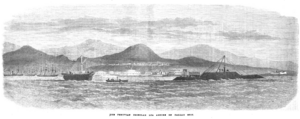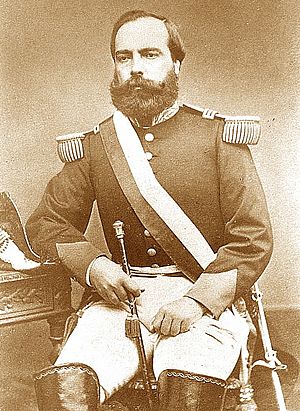USS Nyack (1863) facts for kids
Quick facts for kids History |
|
|---|---|
| Name | USS Nyack |
| Builder | New York Navy Yard |
| Laid down | 25 March 1863 |
| Launched | 6 October 1863 |
| Commissioned | 28 September 1864 |
| Decommissioned | 15 March 1871 |
| Fate | Sold, 30 November 1883 |
| General characteristics | |
| Type | Screw gunboat |
| Displacement | 836 long tons (849 t) |
| Length | 179 ft 6 in (54.71 m) |
| Beam | 29 ft 8 in (9.04 m) |
| Draft | 11 ft 6 in (3.51 m) |
| Speed | 10 knots (19 km/h; 12 mph) |
| Armament |
|
The USS Nyack was a wooden gunboat used by the United States Navy. It was named after the town of Nyack, New York. The name "Nyack" comes from a Native American word meaning "point" or "corner." This ship played a part in the American Civil War. After the war, it sailed to the Pacific Ocean. There, it patrolled the west coast of South America. The Nyack was taken out of service in 1871 and later sold in 1883.
About the USS Nyack
Building the Ship
The Nyack's wooden body was built at the New York Navy Yard. Its construction started on March 25, 1863. The ship was about 180 feet (55 m) long. It was 29 feet 8 inches (9.04 m) wide. When fully loaded, it sat 11 feet 6 inches (3.51 m) deep in the water.
The ship's engines were designed by Benjamin F. Isherwood, a chief engineer for the Navy. South Brooklyn Iron Works built the engines. The Nyack had two coal-powered boilers. These boilers made steam for two steam engines. The engines turned a single propeller. This allowed the ship to reach a top speed of 10 knots.
What Was on Board?
When first built, the Nyack carried several powerful guns. These included:
- A 100-pounder Parrott rifle (a type of cannon)
- A 30-pounder Parrott rifle
- Two 9-inch Dahlgren smoothbore guns
- Two 24-pounder guns
- Two 12-pounder rifles (one light, one heavy)
The ship's guns were changed a few times during its service.
The Nyack was launched on October 6, 1863. Emma Paulding, the daughter of Admiral Hiram Paulding, officially named the ship. The Navy received the ship on July 20, 1864. It officially began service on September 28, 1864. Lieutenant Commander L. Howard Newman was its first commander. The ship cost about $257,952.12 to build. It had a crew of about 100 sailors.
A Commander's View of the Ship
Rear Admiral David Porter commanded the Nyack during the Civil War. He thought highly of the ship and others like it. He said these ships were "a perfect success as steam gunboats." He noted they were "fast, steady at sea," and met all the needs for a good warship. He also said they were "unsurpassed" as sea-boats.
The Nyack's Adventures
Fighting in the Civil War
The Nyack joined the North Atlantic Blockading Squadron during the Civil War. Its job was to help block the ports of the Confederacy. This stopped supplies from reaching them. The ship was active in this blockade by November 1864.
First Battle of Fort Fisher
On December 23, 1864, the Nyack took on coal. Then, it joined Admiral Porter's fleet in the Cape Fear River. They were preparing for the first attack on Fort Fisher. On December 25, 1864, the Nyack began firing on the fort. Later that day, Admiral Porter ordered the Nyack to move closer to the beach. It anchored in only 30 feet (9.1 m) of water. This allowed its guns to better support the troops landing on shore. The ship fired constantly during this part of the battle. Even though the fort's guns were silenced, the landing troops could not capture it. They had to pull back.
Second Battle of Fort Fisher
Admiral Porter quickly planned a new attack. His fleet set sail again on January 12, 1865. By January 13, they were anchored near Fort Fisher once more. During the second attack on Fort Fisher, the Nyack was positioned at the "Old Inlet" entrance to the Cape Fear River. From there, its crew could hear the distant sounds of the battle. The crew also saw Confederate troops destroy Fort Caswell after the Union victory at Fort Fisher. However, the Nyack did not directly take part in this second battle.
Battle of Fort Anderson
On February 17, 1865, Porter's fleet moved up the Cape Fear River. They began firing on Fort Anderson. The Nyack joined this bombardment on February 18, 1865. The Confederate guns stopped firing by 3 pm. With 8,000 Union troops approaching, the Confederates left the fort that night.
After these battles, the Nyack returned to the New York Navy Yard. It arrived on April 3, 1865. The ship went into drydock to get ready for duty overseas.
Patrolling the Pacific
The Nyack was then sent to the Navy's Pacific Squadron. It left New York for Valparaiso, Chile, on July 22, 1865. The journey was long. It stopped in St. Thomas, Virgin Islands, and Rio de Janeiro, Brazil. It sailed through the Strait of Magellan. The Nyack finally reached Valparaiso on November 20, 1865.
For the next five years, the ship sailed along the coasts of Panama, Ecuador, Peru, and Chile. Its main job was to protect American citizens and their interests. It also tried to avoid getting involved in conflicts between Spain and its former colonies.
Helping Out in Peru
For example, on February 1, 1866, the Nyack sailed to Callao, Peru. There, it helped the Peruvian Navy. The Nyack towed the Peruvian ironclad Loa off a sandbar in the harbor. This might have seemed like taking sides to Spain, which was at war with Peru. The Nyack then sailed to Panama City, Panama. It arrived on June 22, 1866. By this time, Lieutenant Commander Austin Pendergast was in command. The previous captain, Newman, had passed away.
In January 1868, Mariano Ignacio Prado, the President of Peru, was overthrown. He found safety at the home of the United States ambassador. The Nyack then took him safely to Chile.
Exploring Panama
In January 1870, the Nyack was ordered to help with a new project. This was an expedition to the Darien region of Panama. A U.S. team was exploring if a canal could be built there. The Nyack was tasked with surveying parts of the Gulf of San Miguel and the Savanna River. The ship arrived on the Savanna River on April 13, 1870. It surveyed 16 miles up the river. Four of its smaller boats went even further up the river.
After this expedition, the Nyack went to Panama City for supplies. A large fire broke out in the town. Sixty of the ship's crew helped fight the blaze. The ship's engines were damaged, so it sailed to Callao for repairs.
Journey to Hawaii
The Nyack later sailed to Honolulu, Hawaii. It arrived there on December 31, 1870. The ship's boilers were badly damaged. The trip from Callao to Hawaii took 45 days. On January 14, 1871, the rescued crew of the wrecked USS Saginaw came aboard the Nyack. However, because the Nyack was in poor condition, the Saginaw's crew was moved to another ship, the Moses Taylor, which took them to San Francisco. On January 26, 1871, Captain Glass, the Nyacks commander, met King Kamehameha V. This was to thank the king for helping rescue the Saginaws crew. The Nyack arrived in San Francisco from Hawaii on February 24, 1871.
End of Service
On February 28, 1871, Captain Glass and all his officers left the Nyack. The ship was officially taken out of service on March 15, 1871. In March 1871, the Nyack was inspected at the Mare Island Naval Shipyard. It was likely too expensive to repair. So, it was put into "ordinary" status. This meant it was kept as a reserve ship without a full crew.
The Nyack was sold on November 30, 1883, for $6,500. It was bought by W. E. Mighell. He had the ship towed to Cresham's Point. There, it was taken apart in December 1883.



